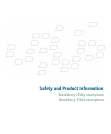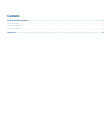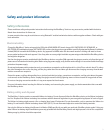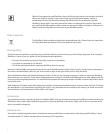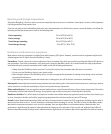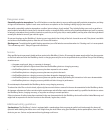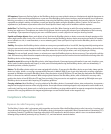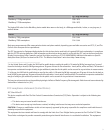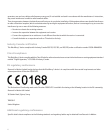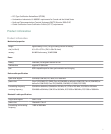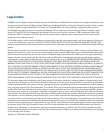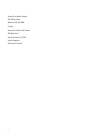• ANSI/IEEE C95.1, 1999, American National Standards Institute/Institute of Electrical and Electronics Engineers Standard for Safety
Levels with Respect to Human Exposure to Radio Frequency Electromagnetic Fields, 3 kHz to 300 GHz
• National Council on Radiation Protection and Measurements (NCRP) Report 86, 1986, Biological Effects and Exposure Criteria for
Radiofrequency Electromagnetic Fields
• Health Canada, Safety Code 6, 1999, Limits of Human Exposure to Radiofrequency Electromagnetic Fields in the Frequency Range
from 3 kHz to 300 GHz
• EN 50360, 2001, Product standard to demonstrate the compliance of mobile phones with the basic restrictions related to human
exposure to electromagnetic fields (300 MHz to 3 GHz)
• International Commission on Non-Ionizing Radiation Protection (ICNIRP), 1998, Guidelines for Limiting Exposure to Time-Varying
Electric, Magnetic, and Electromagnetic fields (up to 300 GHz)
• Official Journal of the European Union (OJEU), 1999, Council Recommendation of 12 July 1999 on the limitation of exposure of the
general public to electromagnetic fields (0 Hz to 300 GHz)
To maintain compliance with FCC, IC, and EU RF exposure guidelines when carrying the BlackBerry device on your body, use only accessories
that are supplied or approved by Research In Motion (RIM). Use of accessories that are not expressly approved by RIM might violate FCC,
IC, and EU RF exposure guidelines and might void any warranty applicable to the BlackBerry device. If you do not use a body-worn accessory
supplied or approved by RIM when carrying the BlackBerry device, keep the BlackBerry device at least 0.98 inches (25 mm) from your
body when the device is connected to a wireless network. When using any data feature of the BlackBerry device, with or without an
accessory cable, position the device at least 0.98 inches (25 mm) from your body.
Specific absorption rate data
THIS WIRELESS DEVICE MODEL MEETS GOVERNMENT REQUIREMENTS FOR EXPOSURE TO RADIO WAVES.
The BlackBerry® device is a radio transmitter and receiver. It is designed and manufactured not to exceed the emission limits for exposure
to radio frequency (RF) energy set by the Federal Communications Commission (FCC) of the U.S. Government, Industry Canada of the
Canadian Government (IC), and recommended by The Council of the European Union. These limits are part of comprehensive guidelines
and establish permitted levels of RF energy for the general population. The guidelines are based on standards that were developed by
independent scientific organizations through periodic and thorough evaluation of scientific studies. The standards include a substantial
safety margin designed to assure the safety of all persons, regardless of age and health.
The exposure standard for wireless devices employs a unit of measurement known as the Specific Absorption Rate, or SAR. The SAR limit
set by the FCC/IC is 1.6W/kg*. The SAR limit recommended by The Council of the European Union is 2.0W/kg**. Tests for SAR are conducted
using standard operating positions specified by the FCC/IC with the device transmitting at its highest certified power level in all tested
frequency bands. Although the SAR is determined at the highest certified power level, the actual SAR level of the device while operating
can be well below the maximum value. This is because the device is designed to operate at multiple power levels so as to use only the
power required to reach the network. In general, the closer you are to a wireless base station antenna, the lower the power output.
Before a wireless device model is available for sale to the public, it must be tested and certified to the FCC, IC, and The Council of the
European Union that it does not exceed the limit established by the government-adopted requirement for safe exposure under the
recommendations of the International Commission on Non-Ionizing Radiation Protection (ICNIRP). The tests are performed in positions
and locations (for example, at the ear and worn on the body) as required by the FCC, IC, and The Council of the European Union for each
model.
The highest SAR value for each device model when tested for use at the ear is outlined below:
8



